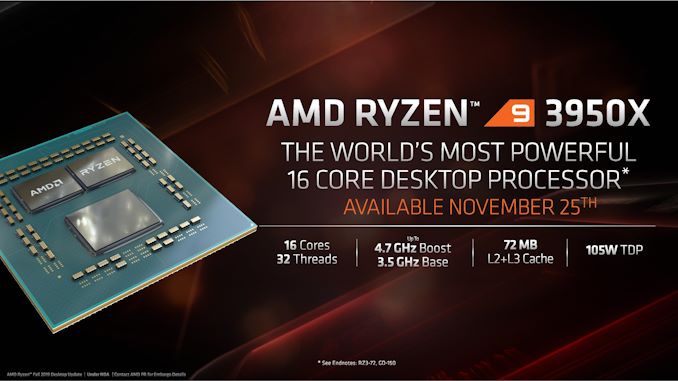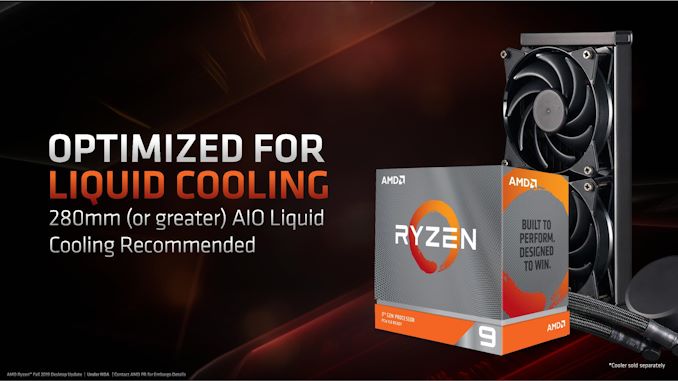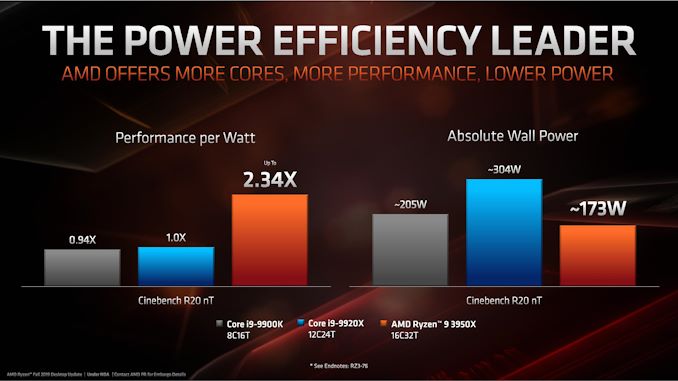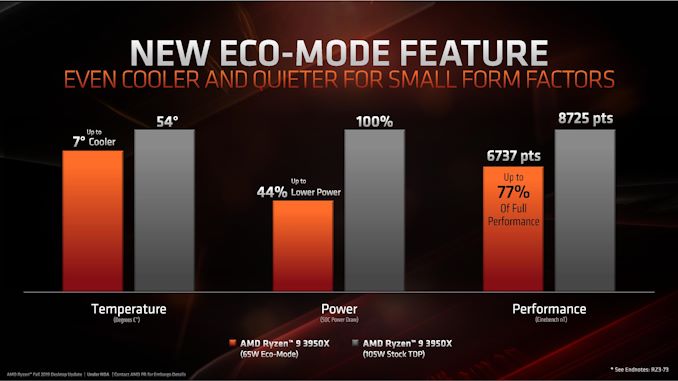AMD Q4: 16-core Ryzen 9 3950X, Threadripper Up To 32-Core 3970X, Coming November 25th
by Dr. Ian Cutress on November 7, 2019 9:00 AM ESTHigh-End Desktop? What’s That?
The Ryzen 9 3950X Comes Into View
As teased at E3 and seemingly every show that AMD has been to since, we’re now ready to get our hands on AMD’s top-tier consumer-grade processor. The Ryzen 9 3950X is the bigger cousin to the Ryzen 9 3900X, this time using two 8-core chiplets built on TSMC’s 7nm process with the Zen 2 microarchitecture. This is paired with the same I/O die, and overall this Ryzen 9 3950X will offer four more cores and +100 MHz on the turbo frequency over the 3900X, all at a $749 recommended retail price point.
| AMD 'Matisse' Ryzen 3000 Series CPUs | |||||||||||
| AnandTech | Cores Threads |
Base Freq |
Boost Freq |
L2 Cache |
L3 Cache |
PCIe 4.0 |
Chiplets IO+CPU |
TDP | Price (SEP) |
||
| Ryzen 9 | 3950X | 16C | 32T | 3.5 | 4.7 | 8 MB | 64 MB | 16+4+4 | 1+2 | 105W | $749 |
| Ryzen 9 | 3900X | 12C | 24T | 3.8 | 4.6 | 6 MB | 64 MB | 16+4+4 | 1+2 | 105W | $499 |
| Ryzen 9 | 3900 | 12C | 24T | 3.1 | 4.3 | 6 MB | 64 MB | 16+4+4 | 1+2 | 65W | OEM |
| Ryzen 7 | 3800X | 8C | 16T | 3.9 | 4.5 | 4 MB | 32 MB | 16+4+4 | 1+1 | 105W | $399 |
| Ryzen 7 | 3700X | 8C | 16T | 3.6 | 4.4 | 4 MB | 32 MB | 16+4+4 | 1+1 | 65W | $329 |
| Ryzen 5 | 3600X | 6C | 12T | 3.8 | 4.4 | 3 MB | 32 MB | 16+4+4 | 1+1 | 95W | $249 |
| Ryzen 5 | 3600 | 6C | 12T | 3.6 | 4.2 | 3 MB | 32 MB | 16+4+4 | 1+1 | 65W | $199 |
| Ryzen 5 | 3500X | 6C | 6T | 3.6 | 4.1 | 3 MB | 32 MB | 16+4+4 | 1+1 | 65W | OEM |
The Ryzen 9 3950X will be compatible in the majority of AM4 motherboards, although in order to take advantage of the 24 PCIe 4.0 lanes on the CPU, an X570 motherboard is recommended. The 16 cores offer a 3.5 GHz base frequency and a 4.7 GHz single core boost frequency; the overall all-core turbo frequency will be dependent on the motherboard used, the quality of the silicon, and the turbo in play.
The 105W TDP matches that of the 12-core part, and it should be noted that the 3950X will not come with an in-the-box cooler. Instead, AMD argues that customers looking at this price range of CPU typically go out and purchase their own, something better than the 125 W Wraith Prism that AMD might have put in the box. To that end AMD is going to publish a list of recommended cooling solutions that are pre-validated by AMD on the website, which should be live on today (the 7th).
Regarding BIOS and AGESA versions on motherboards: AMD has stated that AGESA 1.0.0.4B (also known as 1.0.0.4 Patch B) is going to be required in order to enable full performance on the Ryzen 9 3950X. AMD stated that this AGESA version actually unites several different groups of Ryzen CPUs under the same numbering scheme, to make it easier to manage. It is worth noting that when quizzed, AMD acknowledged that some motherboard manufacturers were putting out ‘beta’ versions of 1.0.0.4B, rather than the full release, and they recommend that users should wait for a full 1.0.0.4B version for their motherboard (even though some motherboard manufacturers aren’t exactly being clear).
In terms of performance, AMD claims a +22% single thread performance jump for the 3950X over the 2700X, in 1080p gaming the company claims it goes toe-to-toe against the Core i9-9900K and trounces the Core i9-9920X (a $1200 CPU), and in content creation it surpasses both the 9900K and 9920X by 18-79% in selected tests. The company also states that a 16-core 3950X uses less wall power than an 8-core 9900K system.
| Unlocked CPU Pricing and Select Others |
||||
| AMD (MSRP Pricing) |
Cores | AnandTech | Cores | Intel* (OEM Pricing) |
| $900-$999 | 18/36 | Core i9-10980XE ($979) | ||
| $800-$899 | ||||
| Ryzen 9 3950X ($749) | 16/32 | $700-$799 | 14/28 | Core i9-10940X ($784) |
| $600-$699 | 12/24 | Core i9-10920X ($689) | ||
| $500-$599 | 10/20 8/16 |
Core i9-10900X ($590) Core i9-9900KS ($513) |
||
| Ryzen 9 3900X ($499) | 12/24 | $400-$499 | 8/16 | Core i9-9900K/F ($488) |
| Ryzen 7 3800X ($399) | 8/16 | $350-$399 | 8/8 | Core i7-9700K/F ($374) |
| Ryzen 7 3700X ($329) | 8/16 | $300-$349 | ||
| $250-$299 | 6/6 | Core i5-9600K ($262) | ||
| Ryzen 5 3600X ($249) | 6/12 | $200-$249 | ||
| Ryzen 5 3600 ($199) | 6/12 | Below $200 | 4/4 | Core i3-9350K ($173) |
| *Intel quotes OEM/tray pricing. Retail pricing will sometimes be $20-$50 higher. | ||||
With Intel cutting its upcoming Cascade Lake-X HEDT processor line in half (and conveniently not releasing a 16-core part), the field does get a little more competitive for anyone looking at building a holiday system. What is important to note here is that AMD is shifting the line between consumer and high-end desktop higher: users spending $749 on a CPU get a ton of cores, but if they need more PCIe lanes, they have to go even higher to get the latest and greatest (see 3rd Gen Threadripper below). On a different note, AMD did state that Intel’s recent price adjustments had no effect on its product plans.
One side announcement from AMD, regarding all of the Ryzen 3000 hardware, is that every CPU now supports a cTDP down mode through the Ryzen Master software. With the tool, users can select the next power range down from the TDP of the processor. This means that 95W/105W CPUs can be set to run at 65W, then the 65W CPUs can be set to run at 45W, and the 45W CPUs can run at 35W.
AMD is doing this because they have seen a number of customers request high-core count processors at lower TDP values. Rather than releasing a wide array of X and non-X parts to satisfy all different areas of the market, AMD is offering this ‘cTDP down-like’ option for system builders that do want to focus on something like a 65W 16-core processor for their system. This isn’t to say that AMD will not release non-X CPUs in the future (they’re typically cheaper than the X CPUs), but rather than have customers wait for those parts to enter the market, AMD is giving this option to speed up adoption.














171 Comments
View All Comments
Spunjji - Friday, November 8, 2019 - link
Upgrading to a new Intel CPU also requires buying a new motherboard, and you'll only need to change RAM if you're going from DDR3 to DDR4 or your DDR4 is old and slow.Basically, AMD is a better value option and AM4 still has a potential upgrade path to Zen 3. Sounds like your "uninformed" comment is projection.
martinbrice - Thursday, November 7, 2019 - link
I'm really curious how the 3960X and 3970X might game. Sounds like architecturally with the single I/O die, they shouldn't suffer from the NUMA issues of the 2970WX or 2990WX. They're (essentially or precisely?) the same chiplets as the 3900X, but have a greater IHS surface area. Their advertised boost is competitive with 3900X, it'll be a matter of what they can hold as a steady state. They also have a larger cache.It'd be great if we could get all the benefits of the extra cores, PCIe lanes, and memory channels, without having to significantly sacrifice gaming performance.
Total Meltdowner - Thursday, November 7, 2019 - link
I was wondering the same thing. I game on an 1800x just fine at 1440p... This tr3 boosts 500mhz higher with about the same base clock...jospoortvliet - Sunday, November 10, 2019 - link
... and much better IPC. I would expect the TR's to beat your 1800x easily.abufrejoval - Thursday, November 7, 2019 - link
Adjustable cTDP is a godsent, but only if it is run-time adjustable (not just a fixed setting in the BIOS as with some older APUs) and preferably with command line and API: That allows you to really tune the hardware between energy efficient batch processing and fast interactive response times, especially when you can take cores offline similarly at run-time to make sure you hit high-frequency points consistently with the remaining ones (and re-enable them later).That would then turn most of the hundreds of fixed allocation SKUs Intel is selling into "CPU as code".
Of course these cTDP limits would have to be very closely observed (or be adustable), so you can control power vs. temperature limits, depending on if you want to allocate PSU overcapacity to increase boost speeds while there is thermal capacity or if you want a PSU that is energy optimzed, but has few reserves.
M O B - Thursday, November 7, 2019 - link
Why are the TRX40 motherboards all the same? Why aren't there different roles being played out with all of those PCIe lanes the motherboard manufacturer's are being given? Please make a motherboard for those of us who need lots of PCIe lanes and aren't just for gamers.With the TRX40 boards I see 4x PCIe slot on almost every single board--total. Some have a 5th slot, but is a x1.
I have been waiting for something like the X299 WS SAGE/10G to come out on the AMD side for more than a year, but apparently that day will never come.
Hammer_Man - Thursday, November 7, 2019 - link
The slide with the Threadripper prices, reads "New TRX40 Platform With 88 PCIe® 4.0"88 Lanes?
Dose the Chipset use a MUX och do the CPU have all those lanes?
DigitalFreak - Thursday, November 7, 2019 - link
They're probably playing the Intel game of adding the PCIe lanes on the CPU and the chipset together.Death666Angel - Thursday, November 7, 2019 - link
What's not to understand? It talks about the TRX40 platform, which is the chipset and the CPU as a whole and the article shows quite nicely what can be configured how. The CPU has 48 + 8 + 4 + 4 (=64) and the chipset has 8+8+4+4 (=24) which is the 88 number they come up with. 16 of those area already in use for the chipset communication, so 72 can be made available to the use however the motherboard manufacturer choose (as seen on the "AMD TRX40 Platform" slide). This isn't rocket science.pkv - Thursday, November 7, 2019 - link
Very disappointed by two things:(1) lack of retrocompatibility with x399
(2) no clear upgrade route for a setup with 16c/32t; from 1950x (999$) one could go to 2950x (899$); but now there's a 50% premium to go to the first TR40 offering (3960x 1399 $).
Going to 3950x+ x570 is not a solution when you need the pcie lanes provided by TR4.
@Ian: did you hear anything about a future 16c TR 3000, which would overlap with the 3950x obviously ? (Intel has done so in the past, mixing up HEDT and mainstream)